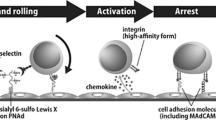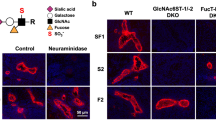Abstract
Sphingosine 1-phosphate (S1P, 1) regulates vascular barrier and lymphoid development, as well as lymphocyte egress from lymphoid organs, by activating high-affinity S1P1 receptors. We used reversible chemical probes (i) to gain mechanistic insights into S1P systems organization not accessible through genetic manipulations and (ii) to investigate their potential for therapeutic modulation. Vascular (but not airway) administration of the preferred R enantiomer of an in vivo–active chiral S1P1 receptor antagonist induced loss of capillary integrity in mouse skin and lung. In contrast, the antagonist did not affect the number of constitutive blood lymphocytes. Instead, alteration of lymphocyte trafficking and phenotype required supraphysiological elevation of S1P1 tone and was reversed by the antagonist. In vivo two-photon imaging of lymph nodes confirmed requirements for obligate agonism, and the data were consistent with the presence of a stromal barrier mechanism for gating lymphocyte egress. Thus, chemical modulation reveals differences in S1P-S1P1 'set points' among tissues and highlights both mechanistic advantages (lymphocyte sequestration) and risks (pulmonary edema) of therapeutic intervention.
This is a preview of subscription content, access via your institution
Access options
Subscribe to this journal
Receive 12 print issues and online access
$259.00 per year
only $21.58 per issue
Buy this article
- Purchase on Springer Link
- Instant access to full article PDF
Prices may be subject to local taxes which are calculated during checkout







Similar content being viewed by others
References
Rosen, H. & Goetzl, E.J. Sphingosine 1-phosphate and its receptors: an autocrine and paracrine network. Nat. Rev. Immunol. 5, 560–570 (2005).
Sanna, M.G. et al. Sphingosine 1-phosphate (S1P) receptor subtypes S1P(1) and S1P(3), respectively, regulate lymphocyte recirculation and heart rate. J. Biol. Chem. 279, 13839–13848 (2004).
Forrest, M. et al. Immune cell regulation and cardiovascular effects of sphingosine 1-phosphate receptor agonists in rodents are mediated via distinct receptor subtypes. J. Pharmacol. Exp. Ther. 309, 758–768 (2004).
Gon, Y. et al. S1P3 receptor-induced reorganization of epithelial tight junctions compromises lung barrier integrity and is potentiated by TNF. Proc. Natl. Acad. Sci. USA 102, 9270–9275 (2005).
Rosen, H., Sanna, M.G. & Alfonso, C. Egress: a receptor-regulated step in lymphocyte trafficking. Immunol. Rev. 195, 160–177 (2003).
Goetzl, E.J. & Rosen, H. Regulation of immunity by lysosphingolipids and their G protein-coupled receptors. J. Clin. Invest. 114, 1531–1537 (2004).
Liu, Y. et al. Edg-1, the G protein-coupled receptor for sphingosine-1-phosphate, is essential for vascular maturation. J. Clin. Invest. 106, 951–961 (2000).
Matloubian, M. et al. Lymphocyte egress from thymus and peripheral lymphoid organs is dependent on S1P receptor 1. Nature 427, 355–360 (2004).
Allende, M.L., Dreier, J.L., Mandala, S. & Proia, R.L. Expression of the Sphingosine 1-Phosphate Receptor, S1P1, on T-cells Controls Thymic Emigration. J. Biol. Chem. 279, 15396–15401 (2004).
Nakayama, T. et al. The generation of mature, single-positive thymocytes in vivo is dysregulated by CD69 blockade or overexpression. J. Immunol. 168, 87–94 (2002).
Feng, C. et al. A potential role for CD69 in thymocyte emigration. Int. Immunol. 14, 535–544 (2002).
Shiow, L.R. et al. CD69 acts downstream of interferon-[alpha]/[beta] to inhibit S1P1 and lymphocyte egress from lymphoid organs. Nature 440, 540–544 (2006).
Mandala, S. et al. Alteration of lymphocyte trafficking by sphingosine-1-phosphate receptor agonists. Science 296, 346–349 (2002).
Rosen, H., Alfonso, C., Surh, C.D. & McHeyzer-Williams, M.G. Rapid induction of medullary thymocyte phenotypic maturation and egress inhibition by nanomolar sphingosine 1-phosphate receptor agonist. Proc. Natl. Acad. Sci. USA 100, 10907–10912 (2003).
Budde, K. et al. Pharmacodynamics of single doses of the novel immunosuppressant FTY720 in stable renal transplant patients. Am. J. Transplant. 3, 846–854 (2003).
Budde, K. et al. First human trial of FTY720, a novel immunomodulator, in stable renal transplant patients. J. Am. Soc. Nephrol. 13, 1073–1083 (2002).
Yagi, H. et al. Immunosuppressant FTY720 inhibits thymocyte emigration. Eur. J. Immunol. 30, 1435–1444 (2000).
Alfonso, C., McHeyzer-Williams, M. & Rosen, H. CD69 down-modulation and inhibition of thymic egress by short and long-term selective chemical agonism of S1P1 receptors. Eur. J. Immunol. 36, 149–159 (2006).
Wei, S.H. et al. Sphingosine 1-phosphate type 1 receptor agonism inhibits transendothelial migration of medullary T cells to lymphatic sinuses. Nat. Immunol. 6, 1228–1235 (2005).
Ley, K. & Morris, M. Signals for lymphocyte egress. Nat. Immunol. 6, 1215–1216 (2005).
Spiegel, S. & Milstien, M. Sphingosine 1-phosphate: an enigmatic signalling lipid. Nat. Rev. Mol. Cell Biol. 4, 397–407 (2003).
Jo, E. et al. S1P1-selective in vivo-active agonists from high-throughput screening: off-the-shelf chemical probes of receptor interactions, signaling, and fate. Chem. Biol. 12, 703–715 (2005).
Davis, M.D., Clemens, J.J., Macdonald, T.L. & Lynch, K.R. Sphingosine 1-phosphate analogs as receptor antagonists. J. Biol. Chem. 280, 9833–9841 (2005).
Sanchez, T. et al. Phosphorylation and action of the immunomodulator FTY720 inhibits VEGF-induced vascular permeability. J. Biol. Chem. 278, 47281–47290 (2003).
McVerry, B. et al. Sphingosine 1-phosphate reduces vascular leak in murine and canine models of acute lung injury. Am. J. Respir. Crit. Care Med. 170, 987–993 (2004).
Singer, I.I. et al. Sphingosine-1-phosphate agonists increase macrophage homing, lymphocyte contacts, and endothelial junctional complex formation in murine lymph nodes. J. Immunol. 175, 7151–7161 (2005).
Miller, M.J., Wei, S.H., Cahalan, M.D. & Parker, I. Autonomous T cell trafficking examined in vivo with intravital two-photon microscopy. Proc. Natl. Acad. Sci. USA 100, 2604–2609 (2003).
Awad, A.S. et al. Selective sphingosine 1-phosphate 1 (S1P1) receptor activation reduces ischemia-reperfusion injury in mouse kidney. Am. J. Physiol. Renal. Physiol. 290, F1516–F1524(2006).
Ho, J.W.Y. et al. Effects of a novel immunomodulating agent, FTY720, on tumor growth and angiogenesis in hepatocellular carcinoma. Mol. Cancer Ther. 4, 1430–1438 (2005).
LaMontagne, K. et al. Antagonism of sphingosine-1-phosphate receptors by FTY720 inhibits angiogenesis and tumor vascularization. Cancer Res. 66, 221–231 (2006).
McVerry, B. & Garcia, J. In vitro and in vivo modulation of vascular barrier integrity by sphingosine 1-phosphate: mechanistic insights. Cell. Signal. 17, 131–139 (2005).
Garcia, J.G.N. et al. Sphingosine 1-phosphate promotes endothelial cell barrier integrity by Edg-dependent cytoskeletal rearrangement. J. Clin. Invest. 108, 689–701 (2001).
McVerry, B. & Garcia, J. Endothelial cell barrier regulation by sphingosine 1-phosphate. J. Cell. Biochem. 92, 1075–1085 (2004).
Graeler, M., Shankar, G. & Goetzl, E. Cutting edge: suppression of T cell chemotaxis by sphingosine 1-phosphate. J. Immunol. 169, 4084–4087 (2002).
Lo, C., Xu, Y., Proia, R. & Cyster, J. Cyclical modulation of sphingosine-1-phosphate receptor 1 surface expression during lymphocyte recirculation and relationship to lymphoid organ transit. J. Exp. Med. 201, 291–301 (2005).
Rosen, H. & Liao, J.Y. Sphingosine 1-phosphate pathway therapeutics: a lipid ligand-receptor paradigm. Curr. Opin. Chem. Biol. 7, 461–468 (2003).
Mahrus, S. & Craik, C.S. Selective chemical functional probes of granzymes A and B reveal granzyme B is a major effector of natural killer cell-mediated lysis of target cells. Chem. Biol. 12, 567–577 (2005).
Hale, J.J. et al. Potent S1P receptor agonists replicate the pharmacologic actions of the novel immune modulator FTY720. Bioorg. Med. Chem. Lett. 14, 3351–3355 (2004).
Miles, A. & Miles, E. Vascular reactions to histamine, histamine liberators or leukotoxins in the skin of the guinea pig. J. Physiol. (Lond.) 118, 228–257 (1952).
Acknowledgements
We thank M. Cameron, L. Lin and P. Griffin for rat pharmacokinetics, B. Webb for LC-MS analysis of mouse plasma, X. Polk for GTP-γS assays, A. Chem for S1P2 and S1P5 GTP-γS assays, O. Safrina for T- and B-lymphocyte preparation and labeling and N. Gray and J. Isbell for access to the Chiralcel column. This work was supported by the National Institutes of Health (AI-055509 and NIMH-074404 to H.R., GM-41514 to M.D.C. and GM-48071 to I.P.). Work in the Rosen laboratory is also supported in part by a grant from Kyorin Pharmaceutical Company.
Author information
Authors and Affiliations
Contributions
M.G.S., P.J.G.-C., A.D., D.M., E.J. and H.R. participated in the design and execution of the biological experiments. S.-K.W., W.-C.C. and C.-H.W. participated in the synthetic chemistry. M.P.M., S.H.W., I.P., M.D.C. and H.R. contributed to the design and execution of the multiphoton microscopy experiments. H.R., I.P., C.-H.W., M.D.C. and M.G.S. wrote the manuscript.
Corresponding authors
Ethics declarations
Competing interests
The authors declare no competing financial interests.
Supplementary information
Supplementary Fig. 1
Inhibition of receptor internalization by antagonist (PDF 94 kb)
Supplementary Fig. 2
Lack of 2a antagonism of S1P3 receptor (receptor activation and MAP kinase phosphorylation) (PDF 42 kb)
Supplementary Fig. 3
Time lapse view of lymphatic sinuses before and after antagonist competition for agonist (PDF 69 kb)
Supplementary Video 1
Two-color imaging of antagonist reversal of medullary T cell arrest by agonist (AVI 281 kb)
Supplementary Video 2
One-color imaging of antagonist reversal of medullary T cell arrest by agonist (AVI 2486 kb)
Supplementary Video 3
Three-color imaging of normal cortical T cell movement in the presence of agonist and antagonist (AVI 1327 kb)
Supplementary Methods
Synthesis and characterization of compounds (PDF 43 kb)
Rights and permissions
About this article
Cite this article
Sanna, M., Wang, SK., Gonzalez-Cabrera, P. et al. Enhancement of capillary leakage and restoration of lymphocyte egress by a chiral S1P1 antagonist in vivo. Nat Chem Biol 2, 434–441 (2006). https://doi.org/10.1038/nchembio804
Received:
Accepted:
Published:
Issue Date:
DOI: https://doi.org/10.1038/nchembio804
This article is cited by
-
Emerging Targets for Modulation of Immune Response and Inflammation in Stroke
Neurochemical Research (2023)
-
S1P-S1PR3-RAS promotes the progression of S1PR3hi TAL1+ T-cell acute lymphoblastic leukemia that can be effectively inhibited by an S1PR3 antagonist
Leukemia (2023)
-
S1P/S1PR1 signaling differentially regulates the allogeneic response of CD4 and CD8 T cells by modulating mitochondrial fission
Cellular & Molecular Immunology (2022)
-
Safety of S1P Modulators in Patients with Immune-Mediated Diseases: A Systematic Review and Meta-Analysis
Drug Safety (2021)
-
Loss of sphingosine 1-phosphate (S1P) in septic shock is predominantly caused by decreased levels of high-density lipoproteins (HDL)
Journal of Intensive Care (2019)



